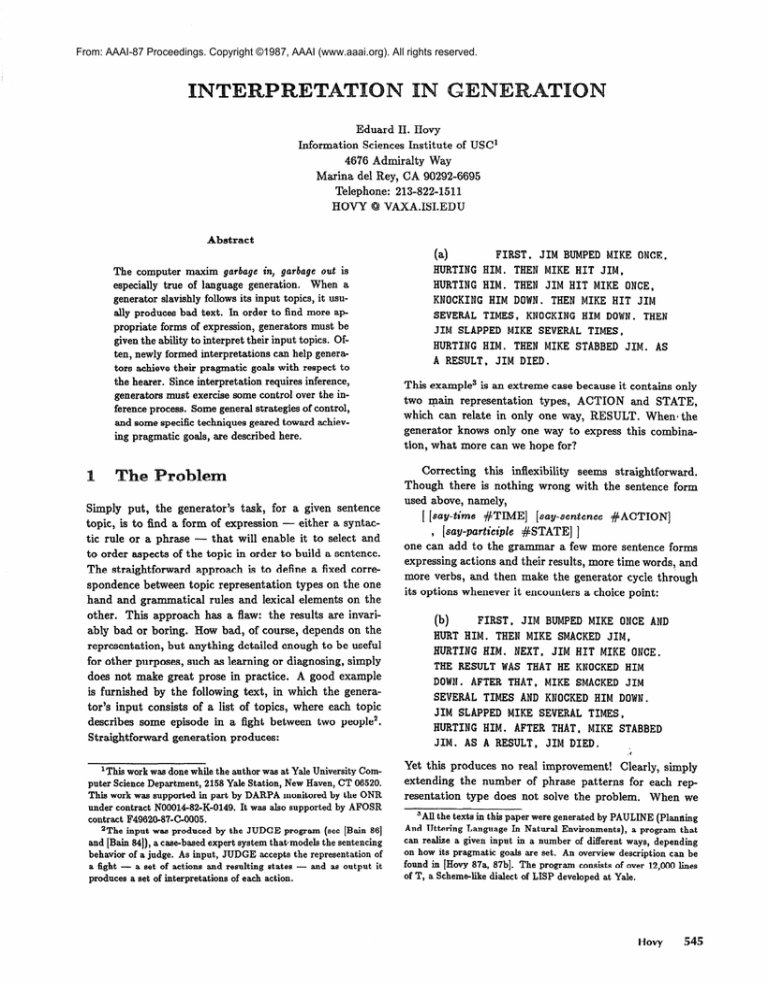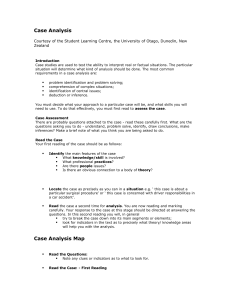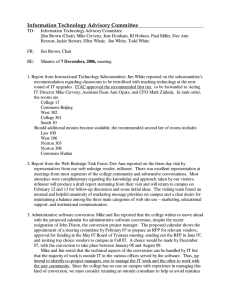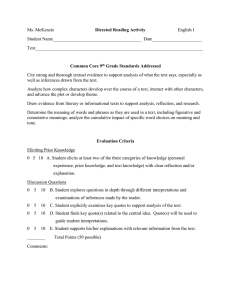
From: AAAI-87 Proceedings. Copyright ©1987, AAAI (www.aaai.org). All rights reserved.
Eduard H. Hovy
Information Sciences Institute of USC1
4676 Admiralty Way
Marina de1 Rey, CA 962926695
Telephone: 213-822-1511
HQVU @ VAXA.ISI.EDU
Abstract
a’he computer maxim garbage in, garbage out is
especially true of language generation. ‘When a
generator slavishly follows its input topics, it usually produces bad text. In order to find more appropriate forms of expression, generators must be
given the ability to interpret their input topics. Often, newly formed interpretations can help generators achieve their pragmatic goals with respect to
the hearer. Since interpretation requires inference,
generators must exercise some control over the inference process. Some general strategies of control,
and some specific techniques geared toward
ing pragmatic goals, are described here.
achiev-
Simply put, the generator’s task, for a given sentence
topic, is to find a form of expression - either a syntactic rule or a phrase - that will enable it to select and
to order aspects of the topic in order to build a sentence.
The straightforward approach is to define a fixed correspondence between topic representation types on the one
hand and grammatical rules and lexical elements on the
other. This approach has a flaw: the results are invariably bad or boring. How bad, of course, depends on the
representation, but anything detailed enough to be useful
for other purposes, such as learning or diagnosing, simply
does not make great prose in practice. A good example
is furnished by the following text, in which the generator’s input consists of a list of topics, where each topic
describes some episode in a fight between two people2.
Straightforward generation produces:
lThis work was done while the author was at Yale University Computer Science Department, 2158 Yale Station, New Haven, CT 06520.
This worh was supported in part by DARPA monitored by the QNR
under contract N00014-82-K-0149.
It was also supported by AFQSR
contract F49820-87-C-0005.
aThe input was produced by the JUDGE program (see [Bain 861
and [Bain 84]), a case-based expert system that models the sentencing
behavior of a judge. As input, JUDGE accepts the representation of
a fight - a set of actions and resulting states - and as output it
produces a set of interpretations of each action.
FIRST,
JIM BUMPED MIKE ONCE,
(4
HURTING HIM. THEN MIKE HIT JIM.
HURTING HIM.
THEN JIM HIT MIKE ONCE,
KNOCKING HIM DOWN. THEN MIKE HIT JIM
SEVERAL TIMES,
KNOCKING HIM DOWN. THEN
JIM SLAPPED MIKE SEVERAL TIMES,
HURTING HIM.
A RESULT,
THEN MIKE STABBED JIM.
AS
JIM DIED.
This examples is an extreme case because it contains only
two main representation types, ACTION and STATE,
which can relate in only one way, RESULT. When1 the
generator knows only one way to express this combination, what more can we hope for?
Correcting this inflexibility seems straightforward.
Though there is nothing wrong with the sentence form
used above, namely,
[ [say-time
#TIME]
y [say-participle
[say-sentence
#STATE]
one can add to the grammar
#ACTION]
]
a few more sentence
forms
expressing actions and their results, more time words, and
more verbs, and then make the generator cycle through
its options whenever it encounters a choice point:
04
FIRST.
HURT HIM.
JIM BUMPED MIKE ONCE AND
THEN MIKE SMACKED JIM,
HURTING HIM.
NEXT,
JIM HIT MIKE ONCE.
THE RESULT WAS THAT HE KNOCKED HIM
DOWN. AFTER THAT. MIKE SMACKED JIM
SEVERAL TIMES AND KNOCKED HIM DOWN.
JIM SLAPPED MIKE SEVERAL TIMES,
HURTING HIM.
JIM.
AFTER THAT, MIKE STABBED
AS A RESULT,
JIM DIED.
.;
Yet this produces no real improvement! Clearly, simply
extending the number of phrase patterns for each representation type does not solve the problem. When we
‘All the texts in this paper were generated by PAULINE (Planning
And Uttering Language In Natural Environments),
a program that
can reslise a given input in a number of different ways, depending
on how its pragmatic goals are set. An overview description can be
found in [Hovy 87a, 87b]. The program consists of over 12,000 lines
of T, a Scheme-like dialect of LISP developed at Yale.
Howy
545
speak, we do a lot more than simply cast input topics in
different forms; for example, we might say:
(c)
JIM DIED IN A FIGHT WITH MIKE.
AFTER JIM BUMPED MIKE ONCE, THEY
(4
FOUGHT, AND EVENTUALLY MIKE KILLED
JIM.
(4
AFTER JIM BUMPED MIKE ONCE. THEY
FOUGHT, AND EVENTUALLY HE WAS KNOCKED
TO THE GROUND BY MIKE.
A FEW TIMES.
HE SLAPPED MIKE
THEN MIKE STABBED JIM.
AND JIM DIED.
Illustrated this way, the problem seems rather simple. Qbviously, the solution is to group together similar enough
topics, where the similarity criterion can be varied depending on external factors, and then to generate the
groupings instead of the individual actions. Grouping together contiguous actions of similar force, PAULINE produced variants (c)) (d) , and (e). (In the first variant, all
actions were grouped together; in the second, all actions
more violent than bumping but less violent than killing
were accepted; and in the third, the grouping resulted
from defining four levels of violence: bumping, hitting
and slapping, knocking to the ground, and killing.)
Clearly, though it improves the JUDGE examples, the
technique of grouping actions by levels of force is very specific and not very useful. However, when “group” is used
in a wider sense to mean “interpret”, this technique becomes both difficult and interesting, and provides a very
powerful way to increase the expressive flexibility and text
quality of a generator. So the questions are: what interpretation/grouping criteria are general and still useful?
When and how should the generator interpret input top
its? How should it ftnd appropriate grouping criteria?
xample of Interpretation
In a second example, PAULINE produces a number of versions describing a hypothetical primary election between
Carter and Kennedy during the 1980 Democratic Presidential nomination race. In thi election, Kennedy narrows
Carter’s lead4. When PAULINE is given as input the outcome for each candidate, straightforward generation produces:
(f1
IN THE PRIMARY ON 20 FEBRUARY
CARTER GOT 1860
VOTES.
KENNEDY
GOT 2186.
4This event is represented using about 80 elements of a representation scheme similar to Conceptual Dependency [&hank 72, 75,
821, defined in a property-inheritance network such as described in
[Char&k, Riesbeck C McDermott 801.
546
Natural Language
However, PAULINE can notice that both outcomes relate
to the same primary, and can say instead:
k)
IN THE PRIMARY ON 20 FEBRUARY,
KENNEDY BEAT CARTER BY 335
VOTES.
(or any of a number of similar sentences using “beat” y
“win”, and “lose”). But why stop there? If PAULINE
examines the input further, it can notice that Carter’s
current delegate count is greater than Kennedy’s, that
this was also the case before the primary, and that this
primary is part of a series that culminates in the final
election, the nomination. In other words, PAULINE can
recognize that what happened in this primary was:
(h)
IN THE PRIMARY ON 20 FEBRUARY,
KENNEDY NARROWED CARTER’S
LEAD BY
GETTING 2f86
1860.
VOTES TO HIS
If we want good text from our generators, we have to give
them the ability to recognize that “beat” or ((lose” or “narrow lead” can be used instead of only the straightforward
sentences (f) .
This ability is more than a simple grouping of the two
outcomes. It is an act of generator-directed inference, of
interpretation, forming out of the two topics a new topic,
perhaps one that does not even exist in memory yet. And
the new topic is not simply a generator construct, but is
a valid concept in memory. The act of determining that
“beat” is appropriate is the act of interpreting the input
as an instance of BEAT - denying this is to imply that
“beat” can logically be used where BEAT is not appropriate, which is a contradiction. This is not an obvious
point; one could hold that the task of finding “beat” to
satisfy a syntactic or pragmatic goal is a legitimate generator function, whereas the task of instantiating it and
incorporating it into memory is not. However, it is clearly
inefficient for a generator to interpret its input, say it, and
then simply forget it again! - especially when there is
no principled reason why generator inferences should be
distinct from other memory processes.
Thus, after interpretation, the newly built instance of
the concept should be added to the story representation,
where it can also be used by other processes, or by the
generator the next time it tells the story. In this way the
content of memory can change as a result of generation.
This is consistent with the fact that you often understand
a topic better after you have told someone about it: the
act of generating has caused you to make explicit and to
remember some information you didn’t have before.
Immediately, this view poses the question: which process in responsible for making these inferences 7. The two
possible positions on this issue reflect the amount of work
one expects the generator to do. According to the strict
minimalist position - a position held by most, if not all,
generator builders today -, the generator’s responsibility is to produce text that faithfully mirrors the input
topics with minimal deviation: each sentence-level input
topic produces a distinct output sentence (though perhaps
conjoined with or subordinated to another). Naturally,
this inflexible attitude gave rise to the JUDGE texts (a)
and (b). To circumvent this problem, in practice, most
generator builders employ in their programs a number of
special-purpose techniques, such as sophisticated sentence
specialists that are sensitive to the subsequent input topics. Of course, this is a tacit acknowledgement that the
strict position does not hold. However, on renouncing the
hard-line position, one must face the question how much
generator-directed
inference are you prepared to do?
I do not believe that a simple answer can be given
to thii question. The issue here, I think, is economic: a
tradeoff exists between the time and effort required to do
interpretation (which includes finding candidate interpretations, making them, and deciding on one) on the one
hand, and the importance of flowing, good text on the
other. Greater expense in time and effort produces better
text. Thus pragmatic criteria are appropriate for treating this question. Hence a reasonable answer is I’22 do as
much inference as I can do, given the available time, the
pragmatic constraints on what I want the hearer to know,
and the richness of my memory and my lexkon. Of these
three factors, the most difficult is clearly the pragmatic
constraints on what the hearer is to be told. When does
the hearer need to know the details of the topic? What is
the effect of telling him only interpretations? Or of telling
him both? The answer can be summarized as: if you can
trust him to make the interpretations himself, then all you
need give him are the details. Thus, if the hearer is a political pundit who is following the nomination race with
interest, then clearly (f) is better, since he can draw the
conclusion without difficulty, and, in addition, he has precise numerical information. If, in contrast, the hearer has
only minimal knowledge about or interest in the nomination procedure, then (h) is better, since it doesn’t burden
him with details and require him to do the interpretation
himself. What must you say, however, if the hearer is interested and has a limited amount of knowledge - say, he
is a student of the political process -, or if he is knowledgeable but unlikely to make the right interpretation say, he is a strong Kennedy supporter, whereas you are
pro-Carter? In both these cases you must ensure that the
hearer understands how you expect him to interpret the
facts. So you tell him details and the interpretations:
(i)
KENNEDY NARROWEDCARTER’S
LEAD IN
THE PRIMARY ON 20 FEBRUARY. HE GOT
2186
VOTES AND CARTER GOT 1850.
In summary, you must be as specific as the hearer’s
knowledge of the topic allows: if you are too specific he
won’t understand, and if you are too general you run the
risk of seeming to hide things from him, or of being uncooperative. In the first case, you violate the goal to be
intelligible, and in the second, you violate the goal to
avoid unacceptable implications. In either case, you violate Grice’s maxim of quantity to say neither more nor
less than is required (see [Grice 751).
The problem in interpretation is to find valid interpretations easily and quickly.
ottom-Up Interpretation:
One solution to this
problem is to try inferences directly on the input topics.
This bottom-up method of interpretation uses the structure of the memory network itself.
In PAULINE, bottom-up interpretation inferences reside in memory and the lexicon as part of the definitions
of concept types. In order to enable bottom-up interpretations, links are defined from concept types to the interpretations in which they could take part. (This scheme
forms a concept representation network slightly different
from the usual multi-parent schemes used in, say, [Stefik & Bobrow $51, [Charniak, Riesbeck & McDermott $01,
and [Bobrow & Winograd 771.) Of course, this is not a
wonderful solution - it depends on the right links being
defined beforehand - but it is practical in limited. domains. The program collects possible inferences from the
type of each input topic.
Topterpretation: Another way to find interpretations is top-down: to run only the inferences likely
to produce results that serve the generator’s pragmatic
goals. Potentially useful inferences can be explicitly included in the plans, and can be tried on candidate sentence topics whenever they are collected. Since interpretation is a powerful way of slanting the text, the pragmatic
goals to communicate opinions are an eminently suitable
source of guidance b. Indeed, many of these goals cam only
be achieved through interpreting the input topics appropriately.
6Ho~ PAULINE is given opinions and some of its techniques for
slanting are described in [Hovy 801.
Hovy
547
PAULINE’s strategies for slanting its text include a
number of top-down interpretation inferences. For example, one strategy for an unsympathetic action is
Interpret as confrontation: state that the
actor you oppose (X) did some action (ACT)
as a confrontation with some actor you support (Y). This rule can be represented as:
IF X has the goal that some actor B must
do some action C
AND Y has goal that B must do C'
AND C' conflicts with C
AND X's action ACT forces B to do C'
(disregardingY)
THEN interpret ACT as a confrontation
; ?X is someone's VOTE-OUTCOME
; in some primary
?Y,
(VOTE-OUTCOME?X
(instance
(ELECTION?Y))
(relations(REL-GREATER0
; and it is greater
than
; another VOTE-OUTCOMEin ?Y
(concl (?X>>
(conc2 (VOTE-OUTCOME0
(instance
(?Y))>>))>
which means: some concept is a VOTE-OUTCOME;
its
aspect RELATIONS contains a GREATER relation of
which the greater part is that same concept and the
smaller
partisanotherVOTE-OUTCOME
in the same
primary. Thus,sinceKennedy'soutcomeresulted
from a
primaryand itisgreater
than Carter's
outcome,thetwo
form an instance of BEATing.
considerably more complex.
Most configurations are
During its planning stage, PAULINE gathers likely in-
Inordertointerpret
theinputtopics
asinstances
ofsome
concept, the interpretation process must recognize when
the topics (or some of them) conform to the definition (or
part of the definition) of the concept. Thus, either concepts must be defined in such a way as to allow a general
process to read their definitions, or inferences must exist
that fire when a definition is matched - in other words,
the antecedent of an inference is the definition and the
consequent asserts the existence of the new concept.
PAULINE was implemented with the second approach,
using patterns called configurations. A configuration is
the description of the way in which a collection of concepts
must relate to one other to form a legitimate instance of
a high-level concept. It contains a pattern, in the form of
a list of triplets (type ?var pattern), where
e type is either the type (in the property inheritance
memory network) of the concept currently to be
matched, or a variable Pvar which must have been
encountered before.
o ?var is either 0, or a variable Pvar by which the cur-
rentconceptwillbe
identified
later
inthematch,or
two such variables that have to be bound to different
concepts for a match.
o pattern is a lit of (aspect config) pairs, where the
filler of each aspect must recursively match the config, which is again a pattern.
Configuration patterns obviously depend on the exact representations used. For example, the configuration for the
concept BEAT is
548
Natural Language
terpretation
inferences,
both top-downand bottom-up,
and then, using a simple pattern-matcher, applies their
configurations to the candidate topics and collects all the
matches. Itsstrategies
forselecting
configurations
are
based upon the pragmatic factors knowledge, slant, and
time,described
above. Ifan instance
of a newly made
interpretation does not yet exist in memory, PAULINE
creates one and indexes it following the memory organization principles described in [Schank 821,so that it can
be found again and used in future.
A final example: PAULINE generates over 100 versions (neutral, slanted in various ways, in various styles)
of an episode that took place at Yale in April 1986. The
episode requires about 120 representation elements. A
neutral version is:
IN EARLY APRIL, A NUMBER OF
(3
STUDENTS BUILT A SHANTYTOWN ON
BEINECKE PLAZA. THE STUDENTS WANTED
YALE UNIVERSITY TO DIVEST FROM
COMPANIES DOING BUSINESS IN SOUTH
AFRICA. ONE MORNING, OFFICIALS
DESTROYED THE SHANTYTOWNAND POLICE
ARRESTED 76 STUDENTS. FINALLY, THE
UNIVERSITY ALLOWED THE STUDENTS TO
REBUILD IT, AND ANNOUNCED THAT A
COMMISSIONWOULD GO TO SOUTH AFRICA IN JULY
TO EXAMINE THE SYSTEM OF APARTHEID.
When generating with the goal to slant the input,
PAULINE uses top-down inferences such as those mentioned above to interpret the input topics. For example,
an anti-protester text is:
4. Char&k,
E., Riesbeck, C.K. & McDermott, D.V.,
(k) IN EARLY APRIL, A SMALL NUMBER OF
rogramming,
Lawrence
STUDENTS [WERE INVOLVED IN A
CONFRONTATION],WITH YALE UNIVERSITY
OVER YALE'S INVESTMENTIN COMPANIES
5. Grice, H.P.,
DOING BUSINESS IN SOUTH AFRICA. THE
Logic and Conversation,
in The Logic of GramSTUDENTS [TOOK ~VER]~BEINECKE PLAZA
mar, Davidson D. & Harman G. (eds), Dickinson
AND CONSTRUCTEDA SHANTYTOWN NAMED
Publishing Company9 1975.
WINNIE MANDELA CITY [IN ORDER TO
FORCE],THE UNIVERSITY TO DIVEST FROM
6. Hovy, E.H. 9
THOSE COMPANIES.YALE REQUESTED THAT
Integrating Text Planning and Production in GenerTHE STUDENTS ERECT IT ELSEWHERE,BUT THEY
ation, IJCAI Conference Proceedings, 1985.
REFUSED TO LEAVE. LATER, AT 6:30 AM ON APRIL
14. OFFICIALS HAD TO DISASSEMBLETHE SHANTYTOWN.7. Hovy, E.H.,
Putting A$ect into Tezt, Proceedings of the Eighth
FINALLY. YALE, [BEING CONCILIATORYI~TOWARD
Conference of the Cognitive Science Society, 1986.
THE STUDENTS, NOT ONLY PERMITTED THEM TO
RECONSTRUCTIT, BUT ALSO ANNOUNCED THAT
8. Hovy, E.H., 1987a,
A COMMISSIONWOULD GO TO SOUTH AFRICA IN
Some Pragmatic Decision Criteria in Generation, in
JULY TO EXAMINE THE SYSTEM OF APARTHEID.
PAULINE made the interpretations confrontation (a) 9 appropriation (b), coercion (c), and conciliation (d),
none of
which were contained in the original input story.
rat ion:
ecent AdIigenee,
SYChOICl~,
G. (ed), Kluwer Aca-
demic Publishers, 1987.
9. Hovy, E-H., P987b,
As generators become larger and more complex, and as
they are increasingly used together with other programs,
they should use the capabilities of those programs to further their own ends. Therefore, we should study the kinds
of tasks that generators share with other processes and
the purposes generators require them to fulfill. The considerations and strategies described here determine some
of the kinds of demands a generator can be expected to
place on a general-purpose inference engine. And even
with PAULINE’s limited inferential capability, the program can greatly enhance the quality of its text and the
efficiency of its communication of non-literal pragmatic
information.
Generating Natural Language under Pragmatic Constraints, in Journal of Pragmatics, vol XI no 6,1987,
forthcoming.
10.Schank, R.C.,
‘Semantics’ in Conceptual Analysi;
in Lingua vol
36 no 2, 1972, North-Holland Publishing Company.
11. Schank, R.C.,
Conceptual
Pnforrrration
Processing,
Holland Publishing Company, 1975;
North-
12. Schank, R.C.,
and Leaning
in Computers
bridge University Press, 1982.
and BeopIe,
Cam-
13. Stefik, &I. & Bobrow, D.G.,
Object-Oriented
Programming:
Themes and Variations, in AI Magazine Vol 6, No 4, 1986.
1.
2.
ain, WM.,
Toward a Model of Subjective Interpretation,
University Technical Report no 324, 1984.
Yale
Bain, WM.,
Case=&& Reasoning: A Computer Model of S’ubjective Assessment, Ph.D. dissertation, Yale, 1985.
3. Bobrow, D.G. & Winograd, T.,
An Overview of KRL, a Knowledge-Representation
Language, in Cognitive Science vol 1 no 1,1977.
Hovy
549





